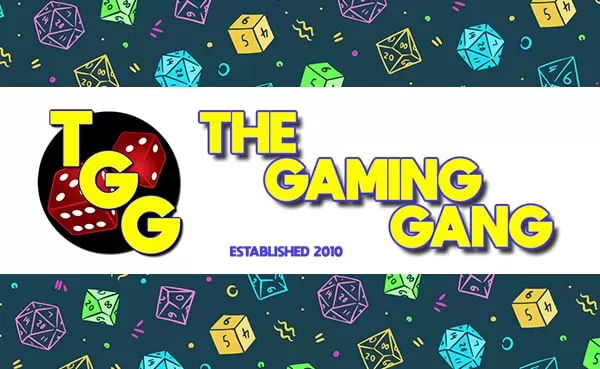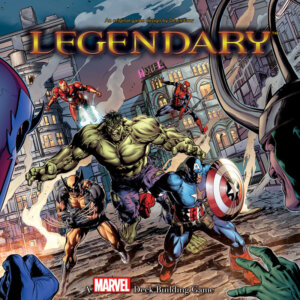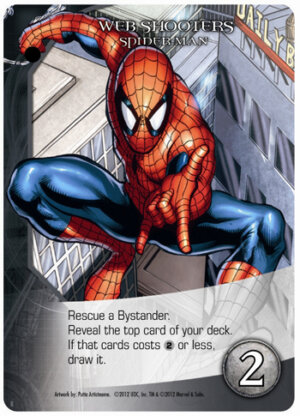Publisher: Upper Deck Entertainment
Designer: Devin Low
Year: 2012
Players: 1 – 5
Ages: 12+
Playing Time: 45 Minutes
Retail Price: $59.99
Category: Deck Building Game
Components:
- 14 cards for each of 15 different Heroes(210 cards) (Each Hero has 1 rare, 3 uncommons,5 of one common, and 5 of another common)
- 8 cards for each of 7 different VillainGroups (56 cards)
- 10 cards for each of 4 differentHenchmen Villain Groups (40 cards)

- 40 S.H.I.E.L.D. Agents
- 20 S.H.I.E.L.D. Troopers
- 30 S.H.I.E.L.D. Officers
- 30 Bystanders
- 30 Wounds
- 4 Masterminds, each with 4 MastermindTactics (20 cards)
- 8 different Schemes
- 11 Scheme Twists
- 5 Master Strikes
- 60 Dividers
From Upper Deck:
Welcome to Legendary, the Marvel Deck-Building Game! Evil Masterminds like Magneto and Dr. Doom lead a horde of powerful Super Villains, planning dark Schemes to destroy the Marvel Universe! Only you can stop them, leading awesome Marvel Super Heroes like Spider-Man, Iron Man, and Wolverine!
I have updated this review since seeing the final product, to give my impressions on the components and such. The first thing I noticed is that the cards are indeed high quality and look great, but I really expected no less from Upper Deck. They might be prone to chipping around the edges, as the artwork does go all the way to the edge. So this is one game you might want to sleeve if you are inclined to do so.
I like the rulebook, the paper may be a bit thin but it is full color and glossy. It would have been cool if they had made it look like a comic book, but it works well as is. They have also included generic divider cards, larger than the regular cards, and plenty of slots in the insert to separate the cards into their various groups. You will find yourself having to sort all of the cards when you first pull them out of the box, as they are not grouped to any rhyme or reason that I could see in their initial stacks. At least you’ll only have to do it the one time.
The artwork is all original and very well done. Not every card is different (there are around 500 cards) but every card type is, so that each superhero and villain has their own artwork which carries through all of their cards.
There are 15 heroes included in the base game and a lot of your favorites are there including Wolverine, Iron Man, Spider-Man, Thor, Captain America, The Hulk, Deadpool and more. Each hero has a stack of 14 cards with different abilities that range from weak to powerful, with each hero having one pretty powerful card that of course costs the most to gain.
On the villain side there are four mastermind bad guys: Loki, Doctor Doom, Magneto, and the Red Skull. The players will be facing one of these masterminds during the game. The mastermind brings along a bevy of other villains that make up the deck of villain cards. There are seven different villain stacks like Hydra, the Brotherhood, and Spider Foes. Along with these are four stacks of henchmen cards, because every mastermind has to have henchmen.
A board is included that holds all of the various card stacks and is covered with Marvel artwork. The version that I saw could be laid out a bit better if you are going to have players sitting around it, as anyone seated at the back of the board will have a hard time seeing and reaching the hero cards on the opposite side of the board.
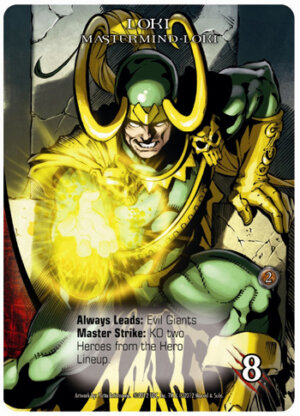
To set up the game, you select five hero stacks randomly and shuffle these up to form the hero deck. Unlike other deck building games there are no randomizer cards included, so you’ll need to figure out you’re own way to randomize them. The hero deck is placed in its spot on the board and the top five cards are flipped over and laid out in the area marked HQ. These make up the cards that the players will be able to purchase on their turn. Whenever a card is purchased, a new one is drawn to take its place.
A stack of wound cards, all the same, are placed on the board. These basically just take up space in your deck similar to other deck building games, and you can obtain or get rid of these in various ways. A stack of bystander cards is placed, and again these are all the same. Bystanders can be captured by villains, and every rescued bystander is worth five victory points.
The Mastermind is selected randomly and his card, along with his four tactics cards (the cards you have to defeat to win) are placed in a stack in the board. Then you’ll need to select a scheme. There are eight scheme cards and each one gives you a different play experience and tells you how to set up the game based upon that scheme. The scheme cards give the victory conditions for the Mastermind to win the game. It adds a lot of theme, and lets you know how many scheme twist cards to put in the villain deck. Scheme twist cards are simply cards that signify some turning point in the Mastermind’s plan. Finally, a few Master Strike cards are selected. These are also all the same, but when drawn will activate the Master Strike ability on the Mastermind’s card. For example, against the Red Skull a Master Strike will force every player to K.O. (discard from the game) a hero from their hand.
You then build the villain deck by selecting villain cards, henchmen, scheme twist cards, Master Strike cards, and a few 
All of the hero cards provide either recruitment points or brawling points. You use recruitment points to buy cards, and brawling points to fight the villains. Each player starts the game with a stack of eight SHIELD Agent cards, which provide one recruitment point when played, and four SHIELD Trooper cards, which provide one brawling point when played. Shuffle these together to form your starting deck, then each player draws six cards for their starting hand.
On your turn the first thing you do is flip a villain card over. If it is a villain, they get placed in one of the five open City spots on the board. As new villain cards appear, the other villain cards move over one spot to make room for the new card. If all five spots get filled, then the card at the end gets removed and placed into the Escaped Villain spot on the board. One of the schemes you will lose if too many villains get away, and other bad things can happen too so the players will want to keep an eye on those bad guys getting away.
The next thing you will do is play the cards in your hand. These will provide both recruitment and brawling points, plus other benefits listed on the cards. You’ll buy cards to add to your deck and you can fight the villains loose in the city. If you have enough brawling points to meet or beat a villain’s fight score listed on their card you can defeat them. The defeated villains are placed in your own separate score pile, along with any bystanders you rescue and Mastermind Tactics cards you obtain. These will be added up at the end of the game to determine the winner. The more villains you defeat, the better chance you have winning the game.
It may sound pretty random to this point, but the hero cards have some features that you can use to build some strategy into your deck to increase your chances of winning. Each hero card has one or more icons representing teams or classes that those cards belong to. The teams are The Avengers, X-Men, SHIELD, and Spider-Friends. If you can combine different cards from a team together you can reap a lot of benefits. For example, Captain America’s rare card gives you +3 brawling for each other Avenger card you play that turn.
Classes include Strength Heroes, Instinct Heroes, Covert Heroes, Tech Heroes, and Ranged Heroes. Combining these will also provide certain benefits. Finally, the cards have different colored borders that I haven’t quite deciphered yet, but combining colors can help you out as well.
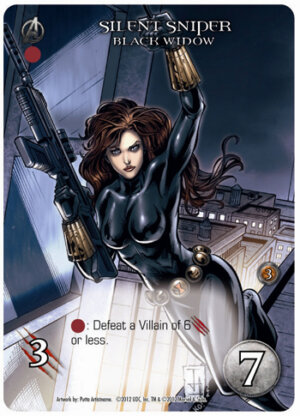
As in any deck building game, things can get confusing once all of the card interactions start coming into play. In one game, on the final turn I was able to put together 35 brawling points from extra cards drawn and bonuses applied. This allowed me to defeat every remaining villain on the board and wipe out the final two Mastermind tactics cards, thus ending the game. The last laugh was on me though, because I actually lost the game as another player had put together five more victory points than me. In effect, I had won the battle but lost the war.
I’ve really enjoyed playing Legendary. The different villains and schemes add a lot of theme to the game. The “Unleash the Power of the Cosmic Cube” scheme has the Mastermind win if a total of eight scheme twist cards are pulled from the villain deck. The “Super Hero Civil War” scheme has you wipe out all of the heroes in HQ every time a scheme twist card comes out. If the hero deck is ever depleted, then the Mastermind wins. “Secret Invasion of the Skrull Shapeshifters” moves the highest cost hero currently in the HQ over to the City as a villain every time a scheme twist card is revealed. These are now Skrull Warriors and if six of them escape, the Mastermind wins. The other schemes are as inventive and provide some variety to every game. I’m hoping Upper Deck releases a bunch more Masterminds and schemes as soon as possible.
The game even has solo play rules, and this was the only time that I ever lost a game to the Mastermind. Solo play is a bit tougher than playing with others, and that made playing solo fun and a challenge. We never lost a game to the Mastermind when playing with two or more players, and if you don’t like this there are optional rules at the back of the rule book for increasing the difficulty. I thought that was a nice touch.
Legendary is a great addition to the deck building world of games with a lot of familiar characters and plots to experience if you are a Marvel fan or even just a fan of deck building games. My only criticism’s are the lack of randomizer cards, the layout of the board, and the layout of the rulebook which I thought could use some improvement. I would have liked different artwork on each scheme card, but it works as is. It does take some time to get a new game set up after the first, because you need to separate all of the different cards back to their own respective stacks and then rebuild the various draw decks. This takes a little longer than your typical deck building game.
- A Dungeon Delve for Kids?: A Review of Dungeon! - Oct 24, 2022
- Better, Stronger, Faster | Descent: Journeys in the Dark Second Edition Reviewed - Oct 23, 2022
- Your Planet is Doomed!: Invasion from Outer Space Reviewed - Oct 22, 2022
